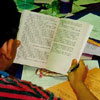| Literature Circles Resource Center | |
| home | site map | structure | books | discussion | written response | themed units | extension projects | |
 |
|
Overview
of Literature Circles |
The Literature Circles Resource Center web site is based on the premise that there is no one way to do literature circles. Literature circles look different in every classroom; they change from teacher to teacher, grade to grade, student to student. Literature circles have no recipe, they are not a specific "program", and they never look the same from year to year -- or even from day to day. The reason? True engagement with literature within a community of learners can't possibly be prescribed -- it can only be described. And that's the goal of this web site. The following links explain how we define literature circles on this web site, describe the role that literature circles play in a comprehensive and balanced literacy program, and illustrate some of the changes that you might expect to see as you work with literature circles in your classroom.
What Are Literature Circles? In literature circles, small groups of students gather together to discuss a piece of literature in depth. The discussion is guided by students' response to what they have read. You may hear talk about events and characters in the book, the author's craft, or personal experiences related to the story. Literature circles provide a way for students to engage in critical thinking and reflection as they read, discuss, and respond to books. Collaboration is at the heart of this approach. Students reshape and add onto their understanding as they construct meaning with other readers. Finally, literature circles guide students to deeper understanding of what they read through structured discussion and extended written and artistic response. Perhaps the easiest way to understand what literature circles are is to examine what they are not.
by Katherine L. Schlick Noe & Nancy J. Johnson © 1999 Christopher-Gordon Publishers, Inc.
Literature circles fit into a comprehensive literacy program as one way for students to apply what they are learning about reading and writing: 
From
Chapter 1, Getting Started with
Literature Circles The
following chart may give you a feel for how literature circles
evolve over time as teachers and students themselves change --
gaining experience, confidence, and insights to do things differently.
The chart isn't based on one teacher's experience, but a composite
of some of the possible steps teachers take as they work with
literature circles. Think of this as a continuum of development
-- flexible and highly subjective. The point of the chart
is to show that we all begin somewhere and grow from there!
From
The Literature Circles Resource
Guide
by Bonnie Campbell Hill, Katherine L. Schlick Noe & Nancy J. Johnson. © 2001 Christopher-Gordon Publishers, Inc.
|
home
| site map | structure
| books | discussion
| written response
| themed
units | extension projects
|
Literature Circles Resource Center © 2004 Katherine L. Schlick Noe College of Education Seattle University kschlnoe@seattleu.edu |